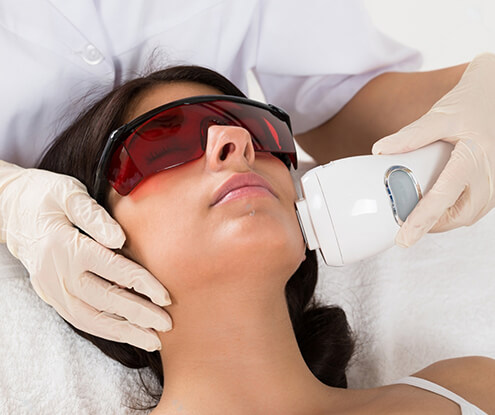Why Study Lasers? Their Scope And Usage In The Cosmetic Industry
Cosmetic Treatments, Laser Treatments -- August 02, 2023
The word laser stands for Light Amplification by Stimulated Emission of Radiation. It is a high-energy light that can be focused on a very small area. The light energy emitted gets converted to heat energy when it penetrates your tissue layers. Lasers can be used for several medical purposes, such as surgical procedures, cancer detection, dermatology (a branch of medicine dealing with the skin), ophthalmology (a branch of medicine specialising in the diagnosis and treatment of diseases of the eye), urology ( a branch of medicine concerned with the urinary system), and cosmetic procedures. Laser therapy has been a revolutionary invention by mankind for several decades since it is safe and effective, with minimal trauma to the surrounding tissues and fewer complications. Read on to learn about the scope and usage of lasers in cosmetics by experts at
Kosmoderma Academy of Aesthetic Medicine (KAAM)Lasers are used to treat various cosmetic skin conditions such as wrinkles, acne, and scars or remove unwanted hair or tattoos. Lasers work in cosmetic procedures through a process known as selective photothermolysis. The frequency of light (photo) is altered to generate heat (thermo) in the specific area that will be destroyed (lysis).
Laser technology finds its application in several cosmetic treatments at
Kosmoderma Academy of Aesthetic Medicine (KAAM), such as:
Skin rejuvenation
- Laser resurfacing is a type of skin rejuvenation procedure that helps fight signs of aging like fine lines, wrinkles, dark spots, dull and sagging skin, uneven skin tone, and acne scars.
- It can be done using ablative lasers (carbon dioxide laser, Er: YAG) and non-ablative lasers (pulsed-dye laser, intense pulsed light therapy).
- The laser removes the outer superficial layer of the skin (epidermis) while heating the underlying skin layer (dermis) to cause micro-injuries. This stimulates the production of collagen (a protein that forms the building block of your skin, hair, bones, cartilage, muscles, etc.).
- This stimulates the growth of new cells in the epidermis, which makes the targeted area smooth and firm.
Removal of birthmarks
- Birthmarks can be effectively reduced using lasers by minimising the melanin levels (a pigment-forming substance).Port-wine stains (red birthmarks), and blue and brown birthmarks can be effectively treated with pulsed dye lasers
Scar treatment
- Lasers can treat many types of scars, including acne scars, surgical scars, and scars from injury or trauma.
- They penetrate into the deeper layers of the skin to generate the growth of new and healthy cells.
- The most common types of lasers used in scar treatment are CO2 (carbon dioxide) lasers, Nd: YAG, and pulsed-dye lasers.
Hair removal
- A concentrated beam of light is targeted at the area of excess hair.
- The melanin in the hair absorbs the light emitted by the laser. The light energy is converted into heat that damages the hair follicles, inhibiting or delaying future hair growth.
Stimulation of hair growth
- Lasers not only aid in unwanted hair removal, but low-power lasers are also used to stimulate hair growth.
- The stem cells in the hair follicles are stimulated, which prolongs the hair cycle's anagen (growth) phase.
- This treatment is known as Low-Level Laser Therapy (LLLT).
Removal of keloids and hypertrophic scars
- Vaporising lasers (CO2 and Er: YAG) is used as an alternative to conventional surgery for the removal of keloids (a raised scar that develops from a wound or injury that has healed) and hypertrophic scars.
Other uses of lasers
- Lasers can sometimes be used to remove skin lesions like warts (a type of skin lesion caused by the human papillomavirus) using a CO2 laser.
- Certain skin cancers (like basal cell carcinoma, melanoma, etc.) are treated with lasers.
Benefits of Laser Cosmetic Treatments
Minimally invasive and non-abrasive laser treatment is popularising in the cosmetic industry. Among the numerous offerings of the cosmetology sector, treatment for acne, anti-ageing solutions, and removal of unwanted hair continue to gain tremendous traction. Laser treatment has been considered a boon!
The benefits of lasers in cosmetic treatments include:
- The procedures are less painful
- The operating time of the treatment is comparatively shorter than conventional surgical procedures
- There is minimal trauma to the surrounding structures and tissues
- Laser cosmetic procedures yield long-lasting results
- The recovery post-laser treatments are quick
- There are fewer side effects and post-procedure complications
Scope of Lasers in Cosmetics
It has been noted that there is a significant rise in the number of laser treatment centres run by highly qualified, trained, and accredited cosmetic laser specialists over the past decades. An unhealthy lifestyle, increase in environmental pollution, growing prevalence of hair and skin-related disorders, and increasing awareness about the benefits of cosmetic laser procedures are further complementing the emergence of new types of laser treatments. Laser technology has come a long way in treating several cosmetic concerns and providing an overall aesthetic appearance. The field of lasers is predicted to grow significantly in the near future and aims to address the requirement for highly skilled doctors to work globally.
The invention of lasers has proven to be the most significant achievement of the twentieth century. Currently, lasers are used in almost all spheres of life, especially medicine, and one of the areas is cosmetology. Laser cosmetic procedures are gaining momentum since they are less invasive, safe, and provide quick and lasting results with shorter recovery times and fewer complications. At
Kosmoderma Academy of Aesthetic Medicine, our experts teach the students the importance of laser applications in the aesthetic space, like hair removal, scar treatment, skin rejuvenation, and several skin disorders. The increasing desire of people to look good is a key element that is driving the growth of laser technology in several cosmetic procedures.

